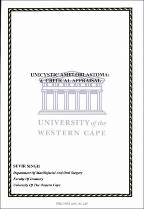| dc.contributor.advisor | Shear, M | |
| dc.contributor.author | Singh, Suvir | |
| dc.date.accessioned | 2022-04-20T13:38:53Z | |
| dc.date.available | 2022-04-20T13:38:53Z | |
| dc.date.issued | 2000 | |
| dc.identifier.uri | http://hdl.handle.net/11394/9059 | |
| dc.description | Magister Chirurgiae Dentium (MChD) | en_US |
| dc.description.abstract | Robinson and Martinez first introduced the entity of unicystic ameloblastoma in 1977. Since
then numerous case reports and series have been published. The evidence suggests that a
more conservative approach can be used successfully to treat the unicystic ameloblastoma.
The term unicystic is derived from the macro- and microscopic appearance of the lesion,
whereas the term unilocular is used in radiological interpretation to describe a radiolucency
having one loculus or compartment. Much confusion stems from the fact that a unicystic
ameloblastoma might appear not only as a unilocular lesion, but also as what is often
interpreted as a multilocular bone defect. | en_US |
| dc.language.iso | en | en_US |
| dc.subject | Ameloblastoma | en_US |
| dc.subject | Unilocular lesion | en_US |
| dc.subject | Radiological | en_US |
| dc.title | Unicystic ameloblastoma: A critical appraisal | en_US |
| dc.rights.holder | University of the Western Cape | en_US |

